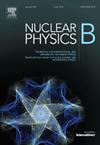Effective quantum gravity black hole with cloud of strings surrounded by quintessence field
IF 2.5
3区 物理与天体物理
Q2 PHYSICS, PARTICLES & FIELDS
引用次数: 0
Abstract
In this study, we investigate a static, spherically symmetric black hole (BH) within the framework of Effective Quantum Gravity (EQG) in the presence of a cloud of strings (CS) and a quintessence field (QF). We derive the modified metric function incorporating quantum corrections and analyze its impact on the horizon structure, geodesic motion, shadow formation, scalar perturbations, and thermodynamics. The metric function is influenced by three key parameters: the quantum correction parameter ξ, the CS parameter α, and the parameters () of the QF. Our results reveal that increasing ξ primarily influences the Cauchy horizon, causing it to expand, while having a negligible effect on the event and cosmological horizons. On the other hand, larger values of α and c lead to an increase in the event horizon radius while reducing the cosmological horizon. The study of null and time-like geodesics indicates that quantum effects modify photon trajectories and the stability of circular orbits. We derive analytical expressions for the radius of the photon sphere and the BH shadow. Our findings indicate that the presence of QF and CS enlarges the shadow radius, whereas the incorporation of effective quantum corrections (ξ) reduces it. Using the Regge-Wheeler equation, we analyze scalar perturbations and greybody factors, demonstrating that ξ suppresses transmission probabilities while enhancing reflection coefficients. This study paves the way for further exploration of EQG-modified rotating BHs, gravitational wave emissions, and astrophysical tests of quantum corrections in future observational studies.
弦云被精粹场包围的有效量子引力黑洞
在这项研究中,我们研究了在有效量子引力(EQG)框架内存在弦云(CS)和精质场(QF)的静态球对称黑洞(BH)。我们推导了包含量子修正的修正度量函数,并分析了它对视界结构、测地线运动、阴影形成、标量微扰和热力学的影响。度量函数受三个关键参数的影响:量子校正参数ξ、CS参数α和量子场参数(c,w)。我们的结果表明,ξ值的增加主要影响柯西视界,使其膨胀,而对事件和宇宙学视界的影响可以忽略不计。另一方面,α和c的较大值导致事件视界半径增大,而宇宙视界减小。零测地线和类时测地线的研究表明,量子效应改变了光子轨迹和圆轨道的稳定性。导出了光子球半径和黑洞阴影半径的解析表达式。我们的研究结果表明,QF和CS的存在扩大了阴影半径,而有效量子修正(ξ)的加入则减小了阴影半径。利用Regge-Wheeler方程,我们分析了标量扰动和灰体因子,证明ξ抑制了透射概率,同时提高了反射系数。这项研究为进一步探索eqg修正的旋转黑洞、引力波发射以及未来观测研究中量子修正的天体物理测试铺平了道路。
本文章由计算机程序翻译,如有差异,请以英文原文为准。
求助全文
约1分钟内获得全文
求助全文
来源期刊

Nuclear Physics B
物理-物理:粒子与场物理
CiteScore
5.50
自引率
7.10%
发文量
302
审稿时长
1 months
期刊介绍:
Nuclear Physics B focuses on the domain of high energy physics, quantum field theory, statistical systems, and mathematical physics, and includes four main sections: high energy physics - phenomenology, high energy physics - theory, high energy physics - experiment, and quantum field theory, statistical systems, and mathematical physics. The emphasis is on original research papers (Frontiers Articles or Full Length Articles), but Review Articles are also welcome.
 求助内容:
求助内容: 应助结果提醒方式:
应助结果提醒方式:


